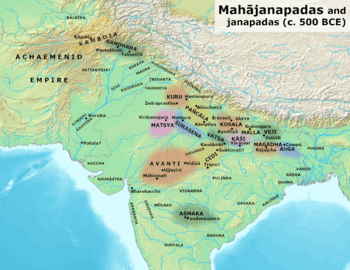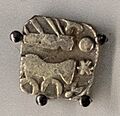Surasena facts for kids
Quick facts for kids
Kingdom of Surasena
|
|
|---|---|
| c. 700 BCE–c. 300 BCE | |

Surasena and other Mahajanapadas in the post-Vedic period.
|
|
| Capital | Mathura |
| Common languages | Sanskrit, Prakrit |
| Religion | Hinduism Buddhism |
| Government | Monarchy |
| Maharaja | |
| Historical era | Bronze Age, Iron Age |
|
• Established
|
c. 700 BCE |
|
• Disestablished
|
c. 300 BCE |
| Today part of | India |
The kingdom of Surasena (IAST: Śūrasena) was an important region in ancient India. It was located where the Braj region in Uttar Pradesh is today. Its capital city was Mathura.
Ancient texts tell us about Surasena. The Buddhist text Anguttara Nikaya lists Surasena as one of the sixteen "Mahajanapadas." These were like big, powerful states in the 6th century BCE. The Hindu epic poem Ramayana also mentions Surasena. Even ancient Greek writers, like Megasthenes, wrote about the people of Surasena and their cities, Mathura and Cleisobora.
Contents
Where Was Surasena Located?
The Surasena kingdom was located along the Yamuna River. Its capital city, Mathura, was also on this river.
The Beginnings of Surasena
Historians believe the Surasena kingdom might have grown from an older kingdom called Sura. This older kingdom was located near the Sarasvati River. The people of Surasena believed they were descendants of the Yadus, a group mentioned in the ancient text called the Rigveda.
Surasena was one of the sixteen "Mahajanapadas," which means "great realms" or "great countries." The Surasena region was home to groups like the Vrishnis and Andhakas. These groups were all part of the Yadu dynasty, a famous ancient tribe.
A Look at Surasena's History
Ancient texts like the Mahabharata and the Puranas talk about the rulers of the Mathura area. They were known as the Yadus or Yadavas. This large group was divided into several smaller families, including the Vrishnis.
Buddhist writings mention Avantiputta, who was the king of Surasena. This was during the time of Maha Kachchana, a main follower of Gautama Buddha. Maha Kachchana helped spread the teachings of Buddhism in the Mathura region.
Mathura, the capital city, was on the Yamuna River. Today, Mathura is a very important and sacred place for Hindus. Ancient Greek writers also mentioned another city in this area, called Cleisobora.
Archaeological digs in Mathura show how a small village slowly grew into a major city. The oldest findings belong to the Painted Grey Ware culture (around 1100–500 BCE). After that came the Northern Black Polished Ware culture (around 700–200 BCE). Mathura became important for trade because of its location. It was where the main northern trade route of the Gangetic Plain met with routes leading to Malwa (central India) and the west coast. This made it a busy hub for goods and people.
Images for kids


